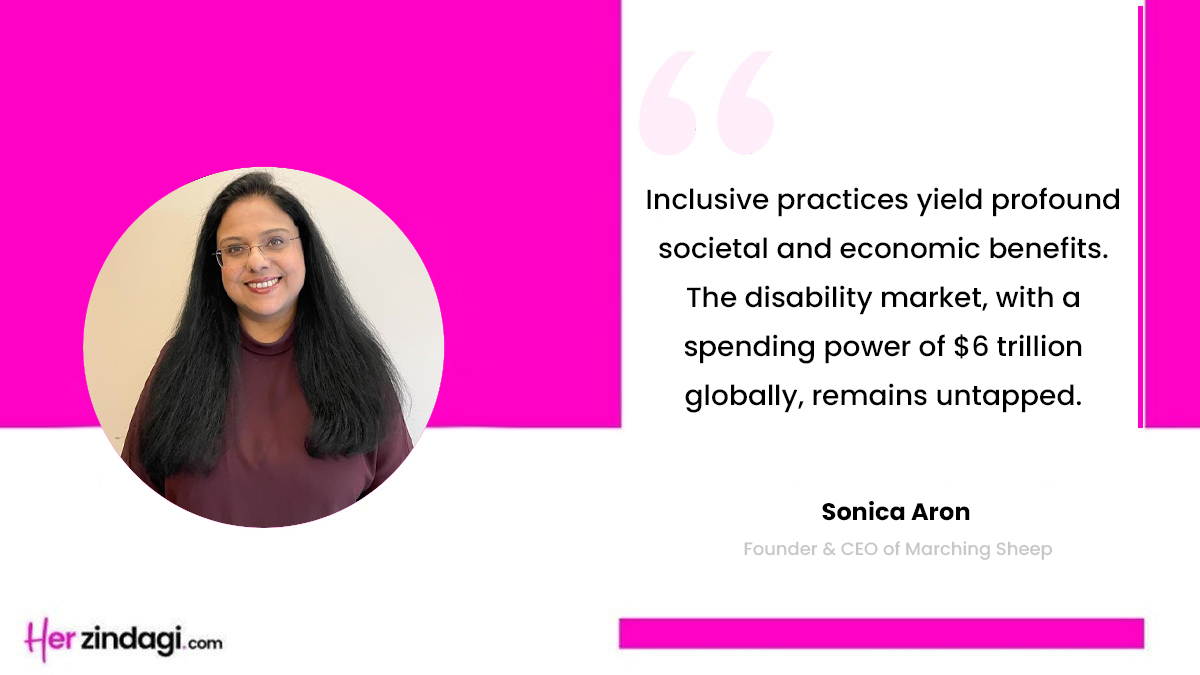
In today’s world, accessibility isn't just about ramps and doorways, it's about creating environments where everyone, regardless of ability, feels included and empowered. But how can companies truly achieve this? In this article, we uncover expert tips and strategies that businesses can adopt to ensure they are not just meeting the minimum standards, but setting a gold standard for inclusivity, shared by Sonica Aron, Founder & CEO of Marching Sheep.
Every May, Global Accessibility Awareness Day (GAAD) sparks crucial conversations about inclusion for people with disabilities worldwide. In India, where approximately 150 million individuals live with disabilities, GAAD serves as a catalyst for India Inc to rethink accessibility as a business imperative, not just a moral obligation.

Inclusive practices yield profound societal and economic benefits. The disability market, with a spending power of $6 trillion globally, remains untapped. Accessible products can boost revenue and foster innovation (e.g., voice assistants). Only 36% of disabled Indians are employed, according to ILO. Inclusive hiring can bridge talent gaps and drive productivity. Accessibility reduces stigma and aligns with UN SDGs, promoting equality.
The 'curb-cut effect', where accessible design benefits all users, underscores the universal value of inclusion.
Nurturing inclusive work environments where everyone is enabled is key to unlocking social and economic potential. GAAD, initiated in 2012, highlights the barriers faced by people with disabilities in accessing digital spaces. With 15% of the global population experiencing disabilities, exclusion from websites, apps, and online services perpetuates inequality. In India, where digital adoption is accelerating, GAAD underscores the urgency for inclusive design. The month-long observance encourages businesses to audit their digital infrastructure, educate teams, and prioritize accessibility, ensuring equitable participation in the digital revolution.
This month reminds us that accessibility extends beyond ramps and braille; it encompasses digital experiences that accommodate diverse needs. This includes:
Globally, the Web Content Accessibility Guidelines (WCAG) outline standards (perceivable, operable, understandable, robust) for digital products. Compliance with WCAG 2.1 (Level AA) is increasingly becoming a benchmark for Indian businesses.
Unfortunately, despite RPWD act 2016, and various amendments to it, BRSR mandating capturing data on PwD inclusion, awareness across India Inc remains uneven. While some sectors like banking and IT are progressive, integrating accessibility into product development, but small and medium enterprises, traditional and manufacturing setups, and startups often lag due to resource constraints. Many firms still view accessibility as a CSR checkbox rather than a growth driver. However, Investor demands, global client demands and India’s Accessible India Campaign (2015) are nudging corporates toward inclusivity. The rise of hybrid work models has further spotlighted the need for accessible collaboration tools, pushing companies to rethink policies and processes.
India’s Rights of Persons with Disabilities Act (2016) mandates accessibility in public services, including digital platforms. Non-compliance risks legal penalties, though enforcement is nascent and patchy. The Act aligns with WCAG 2.0, requiring accessible websites and apps. Additionally, the National Policy on Universal Electronic Accessibility (2013) emphasises inclusive Information and Communication Technology (ICT). Proactive compliance not only mitigates legal risks but also enhances employer brand.
-1745951164327.jpg)
Every step forward is progress and even baby steps are welcome and a source of jow. There are 21 disabilities covered under the RPWD act. This May, get your facilities audited, Physical and digital infrastructure. One need not make all changes in one go but start with some low hanging fruit. Phase out the budgeting. What can be done internally at no cost? What can be done at minimal cost?
Don't Miss: 5 Easy Tax Planning Tips for Salaried Individuals In 2025: Money Matters
For businesses embarking on their accessibility journey here are some simple thought starters:
Global Accessibility Awareness Month is a timely reminder for India Inc to embrace accessibility as a strategic advantage. Beyond compliance, inclusive practices unlock markets, spur innovation, reflect societal progress and ensures no one is left behind. By fostering a culture of inclusion, businesses can drive sustainable growth while transforming lives, a vision where accessibility is not an afterthought, but a cornerstone of corporate India’s future.
Don't Miss: Top 4 Books On Branding That You Must Read: HZ Upskill
If you liked this story, then please share it. To read more such stories, stay connected to HerZindagi.
Also watch this video
Herzindagi video
Our aim is to provide accurate, safe and expert verified information through our articles and social media handles. The remedies, advice and tips mentioned here are for general information only. Please consult your expert before trying any kind of health, beauty, life hacks or astrology related tips. For any feedback or complaint, contact us at compliant_gro@jagrannewmedia.com.